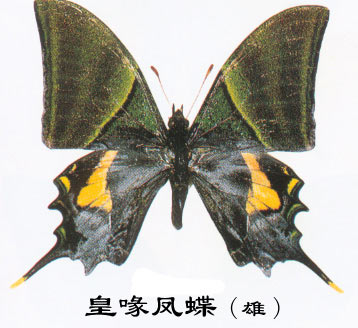The shape of this species is very similar to the golden-spotted swallowtail butterfly, except that the golden spots on the hind wings are band-shaped, so it is also called the golden-spotted swallowtail butterfly.
The adult wingspan is 80 to 100mm. Most of the body and wings are green, and the sexes are dimorphic. The base half of the male butterfly's forewing is dark in color, separated by yellow-green horizontal stripes on the outside and black on the inside; two wide black horizontal bands appear on the end half; there are two parallel black horizontal lines on the outer edge. There is a large golden arc-shaped spot in the middle area of the hind wing; the outer edge is tooth-shaped and has a crescent-shaped yellow spot. On the reverse side, the base of the forewing is emerald green; the end half is reddish brown, with two black horizontal bands that are thin in front and thick in the middle; there are two parallel and very close black lines on the outer edge. The large golden spot on the front of the female butterfly's hind wing is not obvious, and the tooth process on the outer edge grows, and part of it is tail-shaped; the tail process is slender and has a yellow end.

The eggs are slightly spherical, with a shallow concave bottom. Reddish purple, with weak luster. The diameter is about 1.90mm and the height is about 1.52mm.
The first instar larvae has a head width of 1.07 mm, a dark brown head with a yellowish luster, and black primitive hairs, but in large numbers. The three hairs arranged in a straight line in the middle of both sides are the identifying characteristics of this species. The front chest shield is brown, with a tumor process on each side, and 7 long brown hairs that bend forward on the process. The body is dark brown, with a white longitudinal band extending from the baseline of the 3rd abdominal segment to the posterior edge of the 4th abdominal segment, and then connecting at the back. The fifth abdominal segment is white with scattered dark brown spots. The white area of the 6th abdominal segment is greatly reduced and remains only between the valve and the baseline. There is one pair of dark brown long dorsal hairs and one sub-dorsal hair on each section from the middle chest to the 9th abdominal segment. The supraanal plate is brown with 16 long brown hairs with white ends. The thorax and legs are dark brown and the ventral legs are white. The head width of the 2nd instar larvae is 1.69mm. The head width of the 3rd instar larvae is 2.52mm. The head width of the 4th instar larvae is 3.67mm. The head width of the 5th instar larvae is 5.59mm, and the head is light green with an orange luster. The stinkhorns are orange-yellow and curved inward. The body is dark green, turning yellow when looking downward. There are intermittent short black lines on the valve line. The anterior chest shield is dark green, with black spots of different sizes and shapes and inconspicuous hemispherical nodules. The oval eye spots on the back of the metathorax are bright auburn, surrounded by white, purple and black borders. There are two blue spots with thick black edges between the eye spots; the blue spots at the corresponding positions on the 1st to 8th abdominal segments are lighter in color and have thinner black edges. The upper anal plate is green and long trapezoidal. The body length of mature larvae is about 63mm.
The pupa is bright green, translucent, flat and wide, almost diamond-shaped when viewed from the back. The head is prominent and smooth, but with lateral ridges. No brown pupae were found. There is a distinct green dorsal horn on the middle chest. The 2nd to 5th abdominal segments are strongly expanded to both sides along the valve line. There are tumor processes on the 5th to 7th abdominal segments. There is a wide yellow longitudinal band on the back from the top of the mesodorsal horn to the end of the abdomen. Body length 39.7~40.1mm.
Host: Magnolia campbelii of the Magnoliaceae family.
Biology: Adults live in mountainous forests, and are mainly active in broad-leaved evergreen forest belts. On cloudy or foggy days, the protective color on the ventral surfaces of their wings hides them in low shrubs. Adult insects have strong flying power and fast speed, making them difficult to catch. Eggs are laid on the midrib of the host plant leaves, and the egg period lasts about 15 days. After hatching, the larvae move to young leaves to feed. Mature larvae pupate on small branches.
Distribution: Sichuan, Yunnan, Guangxi; Sikkim, Myanmar, Nepal, and Bhutan.
Reasons for endangerment: Massive deforestation and land reclamation in Myanmar, China and the Himalayas have resulted in soil erosion and a sharp reduction in the host plants of this species. The survival requirements of this species have been seriously damaged and its habitat has become narrower; Nepalese Then it entered and seemed to "destroy" the main habitat areas of this species in Nepal, causing a large number of populations and individuals of this species to become extinct or endangered.
In 1998, my country revised the "National Key Wildlife Protection List" to list this species as a key protection object. The governments of India and Nepal have enacted legislation to protect this species, including monitoring its habitat and prohibiting capture.
animal tags:
We created this article in conjunction with AI technology, then made sure it was fact-checked and edited by a Animals Top editor.